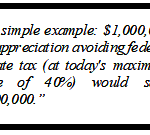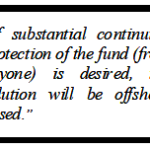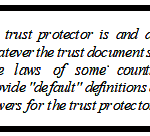Group Trusts – Special Planning Technique Examined
Volume XVI, Number 1 – May 2007
GROUP TRUSTS:
Special Planning Technique Examined
BACKGROUND
A group trust is a trust settled (created) by four or more individuals (for this purpose, a married couple counts as one individual). This technique was developed by Donlevy-Rosen & Rosen, P.A. in 2004 in response to a common problem faced by clients: often a client expressed concern not only about his/her own financial well-being, but also about others participating with the client in a business venture or other common pursuit. However, individual planning was not always economically feasible for all participants in the venture/pursuit, as legal fees for competently implemented individualized offshore trust planning start at around $25,000. The group trust bridged this gap, with legal fees about 40% lower per group settlor.
There is no difference between the protection afforded an individual by the group trust and the protection afforded by an individually designed trust. The only difference, besides substantially lower costs, is the unavailability of custom designed dispositive provisions (see next section).
STRUCTURE
The group trust is established by a single trust instrument. As mentioned above, each group trust will have a minimum of four settlors (participants); the participants will know each other, normally being members of a homogenous group, such as a group of physicians in practice together, a group of church members who want to protect their individual assets as they invest in projects together, etc.
Each settlor will have a separate subtrust under the instrument, and, as with individual trusts, a lawsuit brought against one settlor in the group trust will have no effect on any other settlor. Once a particular group trust is established, no additional settlors can be added, although a settlor can “upgrade” to an individually designed trust and leave the group trust. The dispositive provisions of the group trust (how trust assets are distributed on a settlor’s death) are standardized within the trust as follows: upon the death of a settlor, the deceased settlor’s subtrust will be divided into a credit shelter trust and QTIP trust for the benefit of the settlor’s surviving spouse (maximum estate tax savings), or, if the settlor is not survived by a spouse, but is survived by children or grandchildren, then the assets will be held in trust for them pending their attainment of specified ages (the same ages apply for all children of all settlors’ subtrusts).
If the settlor is survived by neither a spouse nor issue, then the assets will be distributed as appointed (directed) by the settlor in his or her will, and, if such appointment is not made, the deceased settlor’s subtrust will be distributed to the deceased settlor’s heirs-at-law (as determined under the laws of the deceased settlor’s place of residence at the time of death).

Each group trust will have an offshore protector and an offshore trustee. Both the protector and the trustee have reduced their annual fees on a per settlor basis for the group trust plan (approximately 40% lower than fees charged for individual planning).
If the number of group trust participants falls below the minimum number of four (because a settlor has left the group trust for any reason), then the trustee and protector renewal fees charged to each participant will revert to the then standard fees charged by such companies.
For U.S. income tax purposes, the group trust will be treated as a foreign grantor trust with respect to each living settlor. This means that the trust will file an “information” tax return (i.e., paying no tax) with an attached statement showing the amount of income and deductions each settlor will report from his/her separate subtrust, and each settlor will be required to report those items of income and deduction from his/her separate subtrust on his/her individual income tax return.
Finally, upon establishing a plan, a settlor may choose to have his/her subtrust hold a member interest in a limited liability company which the settlor manages – thus retaining a significant degree of direct control over the assets held in the LLC (for more on this technique, see, APN, Vol. X, No. 1, April/May 2001).
ADMINISTRATION
Although liquid assets, such as publicly traded securities which are directly held in the trust (as opposed to being held in the LLC mentioned in the previous paragraph), can be commingled in a single offshore financial account within the trust, separate accounting to each settlor and strict confidentiality of financial matters between settlors is maintained. Thus, for example, if a settlor contributes IBM shares to his subtrust, any dividends on those shares would be allocated solely to that settlor’s subtrust, and any gains or losses generated from the sale of that security would likewise be allocated only to that settlor’s subtrust.
Real estate and other immovable assets can also be effectively protected for each settlor through the implementation of an ancillary loan structure (See APN, Vol. XI, No. 3, November 2002 for details on protecting real estate).
CONCLUSION
The group trust is a valuable planning strategy which “bridges the pricing gap” in making effective asset protection planning available to a broader client spectrum.
For more than twenty years, the attorneys of Donlevy-Rosen & Rosen, P.A. have been leaders in the field of group trusts, asset protection, authoring books, articles, and research materials for other planning professionals. contact us to find out how we may better protect your assets.



















Connect
Connect with us on the following social media platforms.